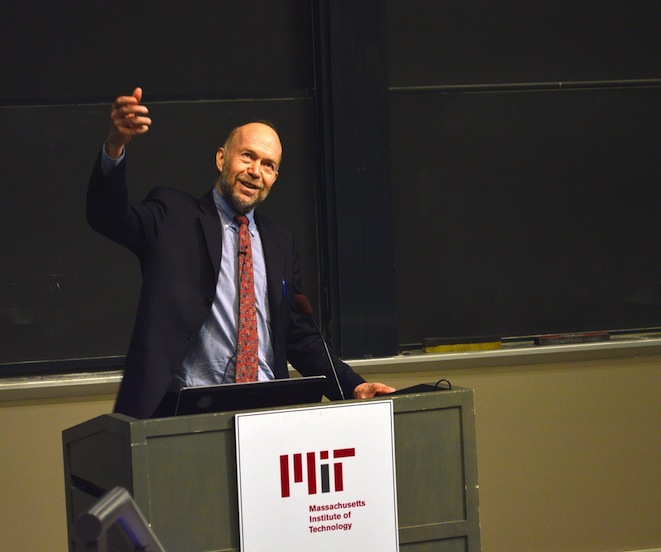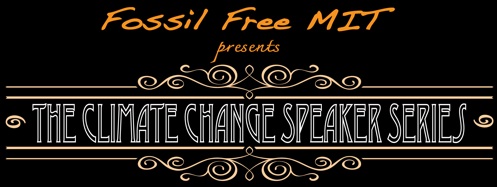Featured Stories | April 23, 2014
Combatting the Climate Crisis James Hansen’s Way
By Genevieve Wanucha
James Hansen visited MIT and advocated for a fee on carbon, a switch to nuclear energy, and the formation of a centrist third political party to solve the climate crisis.
Renowned climate scientist James Hansen recently visited MIT to deliver his public lecture “Combatting the Climate Crisis: the Path from Science to Action” to a crowd of 400 people in MIT 10-250. Hansen, credited with issuing the earliest warning of the 20th century about the dangers of global warming, retired from the NASA climate modeling effort in 2013 to focus his efforts on political and legal actions to cut back greenhouse gases emissions. He currently serves as adjunct professor in the Department of Earth and Environmental Sciences at Columbia University.

This installment of the Climate Change Speaker Series began with introductions from Kurt Sternlof of the MIT Earth System Initiative (ESI) and MIT Fossil Free‘s Geoffrey Supran, a Ph.D. candidate in the Organic and Nanostructured Electronics Laboratory at MIT. MIT Fossil Free, a group of concerned MIT undergrads, grad students, post-docs, faculty, staff, and alumni, is organized around the goal of persuading the MIT administration to divest its fossil fuel portfolio, a cause that receives Hansen’s enthusiastic support.
Hansen first pointed out that because of the ocean’s enormous capacity to store heat, measurements of rising ocean temperature reveal that the Earth is out of energy balance. “More energy is coming in than is going out, so it has to get warmer each decade,” he said. He noted that the pause in warming in the last decade is due to natural variability in ocean circulation, which will reverse over the coming decades.
The implication of ocean warming for Earth’s ice is perhaps Hansen’s biggest concern. While the idea has not gained acceptance amongst all glaciologists, Hansen believes that the ocean could warm enough to cause rapid melting of ice-sheets and glaciers, spelling catastrophe for coastal communities. He takes his evidence from paleoclimate records from the Eemian Period (the interglacial period that began about 130,000 years ago and ended about 114,000 years ago) that show temperatures like those of today and coincident rapid changes in sea level rise. Hansen is convinced that such changes can happen again.
Hansen mentioned that coral reefs, “the jungles of the ocean,” which provide habitats for a million or more species, are vanishing at the rate of 1% per year through anthropogenic ocean acidification and warmer waters.
As for the unabated warming over land, Hansen pointed out that many species are unable to adapt as climate zones consistently shift polewards. The Monarch butterfly holds a special significance to Hansen, as he has personally witnessed the population of Monarchs struggle on his small Pennsylvania farm to maintain their numbers as their habitats diminish in the US, Canada, and Mexico.
Hansen noted that he really wanted to name his talk “Challenge for Young People: How to Make the Unfolding Climate Crisis an Opportunity,” as he feels that the onus of reducing fossil fuel emissions falls on the shoulders of today’s youths and their descendants. “[The climate crisis is] a case of inter-generational injustice,” he said. “Our parents didn’t understand this, but we can only pretend that we don’t understand what we’re leaving for young people.” He asserts that a legal case can be made for children to sue the government for the harm they will have to endure if we continue to use fossil fuels. In fact, he reminded the audience that a Federal lawsuit to force the government to plan for climate recovery and commit to meaningful emission reductions will be heard at the D.C. Circuit Court on May 2, 2014 at 9:30 a.m. Further information can be found at http://www.ourchildrenstrust.org
According to Hansen, the goal to keep global warming below 2 degrees Celsius is not sufficient to avoid the future dangers of sea level rise. He noted that the US simply must de-carbonize the economy and reduce fossil fuel consumption by 30% by 2025. “We have an obligation because we put [developing countries] in a position where we burned our part of the carbon budget, and then started burning their part. And we’ve burned a large fraction of their part. We need to work with China and developing countries to create sources of abundant clean energy,” he said. But Hansen believes that while solar panels and wind farms are valuable tools in our environmental arsenal, alternative energy sources are not enough.
Hansen advocates a fee on all carbon-based fuels. He adamantly opposes a cap-and-trade approach and supports a fee and dividend system, which distributes all the revenues directly to the people, not the government, to offset increasing energy costs. This system would allow the free market to determine how to reduce greenhouse gas emissions. In that regard, he favors new technological developments in nuclear and thorium reactors with improved safety features, citing the successful transition to nuclear power in countries such as France.
After a long Q&A, MIT Fossil Free’s Geoffrey Supran asked the final question of the night: What should MIT students be doing about the climate crisis? Hansen answered that young people must show the government that they care. First, they should attend, in force, the upcoming lawsuit hearing in DC and similar future cases. Ultimately, Hansen envisions the formation of a centrist third political party that places climate change prevention at the core of its public policy agenda. If this party can harness the organizational power of millions of young people, Hansen sees a solution to the climate crisis.






